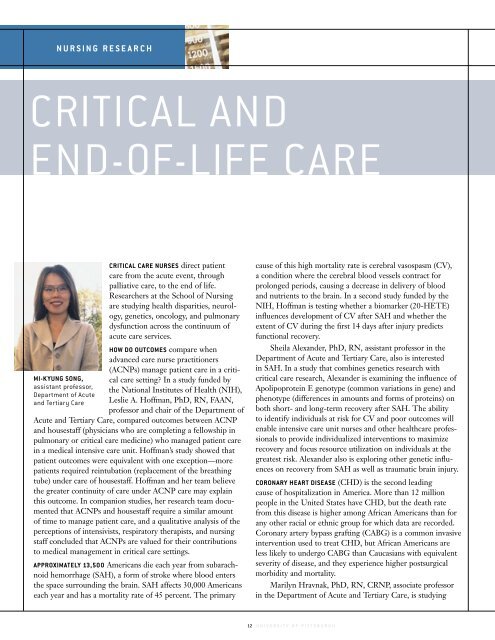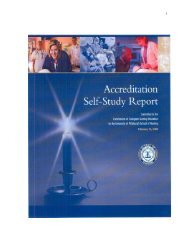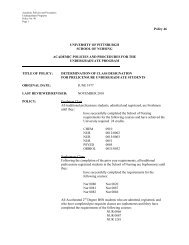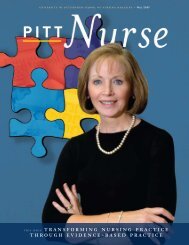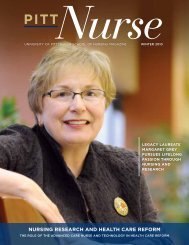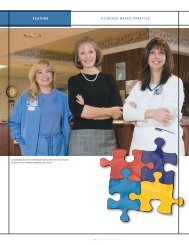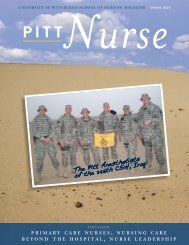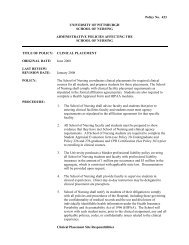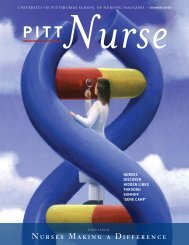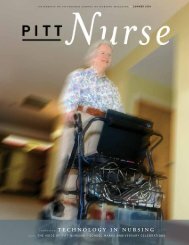complete issue - School of Nursing - University of Pittsburgh
complete issue - School of Nursing - University of Pittsburgh
complete issue - School of Nursing - University of Pittsburgh
Create successful ePaper yourself
Turn your PDF publications into a flip-book with our unique Google optimized e-Paper software.
N U R S I N G R E S E A R C HCritical AndEnd-<strong>of</strong>-Life CareMi-K yung Song,assistant pr<strong>of</strong>essor,Department <strong>of</strong> Acuteand Tertiary CareCritical care nurses direct patientcare from the acute event, throughpalliative care, to the end <strong>of</strong> life.Researchers at the <strong>School</strong> <strong>of</strong> <strong>Nursing</strong>are studying health disparities, neurology,genetics, oncology, and pulmonarydysfunction across the continuum <strong>of</strong>acute care services.How do outcomes compare whenadvanced care nurse practitioners(ACNPs) manage patient care in a criticalcare setting? In a study funded bythe National Institutes <strong>of</strong> Health (NIH),Leslie A. H<strong>of</strong>fman, PhD, RN, FAAN,pr<strong>of</strong>essor and chair <strong>of</strong> the Department <strong>of</strong>Acute and Tertiary Care, compared outcomes between ACNPand housestaff (physicians who are completing a fellowship inpulmonary or critical care medicine) who managed patient carein a medical intensive care unit. H<strong>of</strong>fman’s study showed thatpatient outcomes were equivalent with one exception—morepatients required reintubation (replacement <strong>of</strong> the breathingtube) under care <strong>of</strong> housestaff. H<strong>of</strong>fman and her team believethe greater continuity <strong>of</strong> care under ACNP care may explainthis outcome. In companion studies, her research team documentedthat ACNPs and housestaff require a similar amount<strong>of</strong> time to manage patient care, and a qualitative analysis <strong>of</strong> theperceptions <strong>of</strong> intensivists, respiratory therapists, and nursingstaff concluded that ACNPs are valued for their contributionsto medical management in critical care settings.Approximately 13,500 Americans die each year from subarachnoidhemorrhage (SAH), a form <strong>of</strong> stroke where blood entersthe space surrounding the brain. SAH affects 30,000 Americanseach year and has a mortality rate <strong>of</strong> 45 percent. The primarycause <strong>of</strong> this high mortality rate is cerebral vasospasm (CV),a condition where the cerebral blood vessels contract forprolonged periods, causing a decrease in delivery <strong>of</strong> bloodand nutrients to the brain. In a second study funded by theNIH, H<strong>of</strong>fman is testing whether a biomarker (20-HETE)influences development <strong>of</strong> CV after SAH and whether theextent <strong>of</strong> CV during the first 14 days after injury predictsfunctional recovery.Sheila Alexander, PhD, RN, assistant pr<strong>of</strong>essor in theDepartment <strong>of</strong> Acute and Tertiary Care, also is interestedin SAH. In a study that combines genetics research withcritical care research, Alexander is examining the influence <strong>of</strong>Apolipoprotein E genotype (common variations in gene) andphenotype (differences in amounts and forms <strong>of</strong> proteins) onboth short- and long-term recovery after SAH. The abilityto identify individuals at risk for CV and poor outcomes willenable intensive care unit nurses and other healthcare pr<strong>of</strong>essionalsto provide individualized interventions to maximizerecovery and focus resource utilization on individuals at thegreatest risk. Alexander also is exploring other genetic influenceson recovery from SAH as well as traumatic brain injury.Coronary heart disease (CHD) is the second leadingcause <strong>of</strong> hospitalization in America. More than 12 millionpeople in the United States have CHD, but the death ratefrom this disease is higher among African Americans than forany other racial or ethnic group for which data are recorded.Coronary artery bypass grafting (CABG) is a common invasiveintervention used to treat CHD, but African Americans areless likely to undergo CABG than Caucasians with equivalentseverity <strong>of</strong> disease, and they experience higher postsurgicalmorbidity and mortality.Marilyn Hravnak, PhD, RN, CRNP, associate pr<strong>of</strong>essorin the Department <strong>of</strong> Acute and Tertiary Care, is studying12 u n i v e r s i t y o f p i t t s b u r g h


